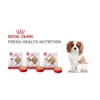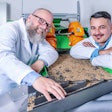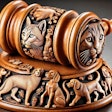
Sustainable dog, cat and other pet food formulators can evaluate any protein source’s effects on human communities, livestock and the environment using a four-part framework developed by the Pet Sustainability Coalition. Caitlyn Dudas, co-founder and executive director of the organization, explained why protein sources were a main target of her group’s work, during her presentation at Petfood Forum CONNECT.
“Proteins have the highest environmental impact compared to other ingredient categories,” she said.
One Coalition member, Germany-based Josera, estimated the carbon dioxide output associated with various pet food ingredients. Production of animal protein, either lamb or insect, accounted for the majority of greenhouse gas pollution, compared to plant-based ingredients, vitamins and minerals. Dudas pointed to other research supporting Josera’s conclusions, but also noted that the topic was controversial.
In response to a question, she noted that pet foods often use rendered meals and other meat co-products from the human food industry. As a major consumer of rendered products, along with muscle tissue, the pet food industry has leverage to demand ecological and social responsibility from the cattle, aquaculture and other meat industries.
Of those meat industries, the poultry industry provides the most common protein in pet food.
“Chicken is used in 80% of pet foods and therefore is the area of focus for us initially.”
Four-part framework for pet food protein evaluation
To evaluate the wider effects on ecosystems and human communities of the chicken used in pet food, formulators and new product developers can use a four-part framework developed by the Pet Sustainability Coalition.
- Environmental impact
Environmental impact measures things like deforestation, greenhouse gas emissions, land and water use.
“The environmental impact of ingredients is an important factor that influences the sustainability of a formula,” said. “It directly influences whether or not that ingredient will be available within the finite planetary boundaries that restrict production.”
- Social impact
Social impact gauges human societal sustainability factors like safe working conditions, fair labor standards and freedom from forced labor or slavery.
“Our moral boundaries also require that the treatment of the workforce which is covered in the social impact section of our model, and the treatment of the animals, which is covered in the animal welfare section of our model,” she said.
- Nutrition
Nutrition measures include nutritional composition, bioavailability and digestibility
“A pet food is only sustainable if it promotes a balanced diet for pets,” Dudas said. “Those that do not sustain the population aren't sustainable by definition. And secondarily, those that provide poor nutrition will likely cause secondary environmental impacts related to veterinary assistance and or supplements and medications, if those are needed to address nutritional deficiency.”
- Animal welfare
Animal welfare includes measured of humane standards of production, including health, prevention of pain and distress, and the promotion of comfort and natural behavior.
Social impact and animal welfare are important to meeting pet food consumer expectations, since those pet owners also tend to care deeply about animals of all kinds, she said.
Advocating for systemic change of pet food supply chain
Evaluating pet food proteins served as an beginning for the Pet Sustainability Coalition’s push for systemic change of the pet food industry supply chain. However, as the organization advocated for sustainability, Dudas realized they had stepped into an emotionally charged debate.
“We were in the middle of a boxing match,” she said. “There were lots of stakeholders in the ring. Everyone was waiting for each other to leave themselves unguarded, so that they could pounce at just the right time.”
Issues included:
- safety
- health
- by-products
- human-grade
- transparency
- farm-raised
- humanely raised
- ethical labeling
- recalls
- eco friendly alternatives
- GMO-free and
- slavery
“PSC’s goal is to change the narrative to move away from these losers conversations where we pit one option against the other,” she said. “Instead we shift the conversation, backed by credible data, around win-win solutions, where ingredients aren't evaluated by a single metric, but instead by their contribution tool holistic sustainable sourcing solution.”
















